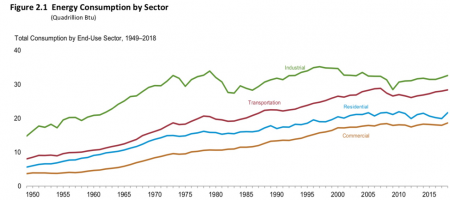Process of Change: United States’ Clean and Affordable Energy
The views expressed are those of the author and do not necessarily reflect the views of ASPA as an organization.
By Candi Choi
October 15, 2019

“Everyone thinks of changing the world but no one thinks of changing himself.” —Leo Tolstoy
Affordable and clean energy is a growing necessity for maintaining resilience against climate change. The United Nation’s has made clean and affordable energy one of its 17 Sustainable Development Goals. The U.N. has called upon leaders of poor, middle and wealthy nations to incorporate new and innovative renewable energy sources with universal access and energy efficiency.
According to the EIA, the United States has consistently consumed more energy than it has produced. In 2018, total United States consumption of renewable energy was 11% of all energy sources. 56% of renewable energy consumed was generated in the form of electricity. Prior to which, the United States has relied mostly on fossil fuels; coal, petroleum, and natural gas. Currently, petroleum and natural gas are still the top energy sources consumed in the United States. But, they are also major contributors to United States carbon dioxide emissions. Therefore, there has been more urgency from the state and federal governments to develop renewable energy policies.

Figure 2.1 shows total energy consumption based on the end-user. The graph shows more energy consumption from industrial and transportation sectors than residential and commercial sectors. However, when breaking down sources of energy per end-user, it is easier to create policies and goals that approach end-user consumption. The residential and commercial sectors rely mostly on natural gas and electricity. The industrial sector relies on petroleum and natural gas. Whereas, transportation relies almost completely on petroleum. The electric power sector still relies on coal and natural gas. The renewable energy industries can locate target markets for the most efficient use of the energy produced. That being so, public policies can guide the target markets with renewable energy incentives and goals.
Many states have implemented energy policies or renewable portfolio standards (RPS) which have shored up rapid growth in the renewable energy industries. Approximately, 17% of United States electricity is generated by renewable energy sources, like hydropower, solar power, biomass and wind energy. The standards require utilities to achieve electricity output targets with renewable sources. Renewable energy credits/certificates are provided for the environmental benefits produced per one megawatt hour (MWh) of renewable energy generated. States’ renewable portfolio standards encourage energy sources variation, emissions reduction and economic development expansion.
In 2015, Hawaii led the most vigorous renewable energy policy (HB 623) calling for 100% RPS by 2045. Vermont established an RPS of 75% by 2032 in HB 40. Since then more states have added rigor to their policies. Washington, DC Bill 904 requires 100% RPS by 2032. In 2018, the Maryland Legislature overrode the Governor’s veto and enacted HB 1106 for 25% RPS by 2020. By May 2019, legislators updated the Maryland policy with SB 516 to include 50% RPS by 2030. As the renewable energy industry grows and prices drop, the RPS mandates will no longer be needed. But, until then, most states are on board with renewable energy and their policies are shaping how the United States will rely on renewables.
In addition to renewable portfolio standards, states have incorporated incentive policies—like net metering, which have aided in the increase of viability for the renewable energy market, including solar panels, natural gas micro-turbines, methane digesters and small wind power generators. These sources of renewable energy are found on the actual sites—houses, municipal buildings or businesses—instead of utility owned properties. Net metering policies simply provide credits to customers in a buy-back type exchange with utility companies. Any excess electricity through on-site distributed generation can be sold back to utility companies for a credit. Thus, this reduces consumption from the utility grid as well as some of the costs associated with transitioning to renewable energy sources.
These are first steps toward expanding the renewable energy industry and building resilience against climate change. So, the only lingering questions remain. What is United States consumption in comparison to actual energy production? According to the EIA, the United States has consistently consumed more energy than it has produced. The United States has consistently imported more energy sources than it has exported. However, in a January-June monthly comparison over the last three years, 2017-2019 the United States Energy Information Administration shows United States energy consumption and production—as well as imports and exports—closing in.
In his Three Methods of Reform, Pamphlets: Translated in Russian (1900), Leo Tolstoy said, “Everyone thinks of changing the world, but no one thinks of changing himself.” Policies aimed at the residential and commercial sectors establish achievable goals because technology is slowly expanding to cater to those energy needs. Proactive approaches that can incorporate the interests of everyone involved and encourage a voluntary effort toward less consumption will depend greatly on everyone’s choices. So, exemplarily leadership capable of making innovative and effective decisions over that of a passive strategy is ideal.
Car developers, like Tesla, have shown that transportation technology can steer the industry toward zero emissions. But, the transportation sector has yet to be inundated with similar cars. Electric power and industrial sectors require more diligence to make strides toward innovative solutions and efficient costs that can meet their energy needs. A well-balanced and proactive approach for expanding the renewable energy market will depend upon values and leadership of all levels of government, industries and the people. Thus, prioritizing effective sustainable development goals, similar to the U.N.’s call for clean and affordable energy, will keep the United States up to date with the growing needs of the 21st century.
Author: Candi Choi holds an MPA with specialization in local government management. She has experience with local budgeting, planning and constituent affairs. Her contact email is [email protected]




 (No Ratings Yet)
(No Ratings Yet)
 Loading...
Loading...
Process of Change: United States’ Clean and Affordable Energy
The views expressed are those of the author and do not necessarily reflect the views of ASPA as an organization.
By Candi Choi
October 15, 2019
Affordable and clean energy is a growing necessity for maintaining resilience against climate change. The United Nation’s has made clean and affordable energy one of its 17 Sustainable Development Goals. The U.N. has called upon leaders of poor, middle and wealthy nations to incorporate new and innovative renewable energy sources with universal access and energy efficiency.
According to the EIA, the United States has consistently consumed more energy than it has produced. In 2018, total United States consumption of renewable energy was 11% of all energy sources. 56% of renewable energy consumed was generated in the form of electricity. Prior to which, the United States has relied mostly on fossil fuels; coal, petroleum, and natural gas. Currently, petroleum and natural gas are still the top energy sources consumed in the United States. But, they are also major contributors to United States carbon dioxide emissions. Therefore, there has been more urgency from the state and federal governments to develop renewable energy policies.
Figure 2.1 shows total energy consumption based on the end-user. The graph shows more energy consumption from industrial and transportation sectors than residential and commercial sectors. However, when breaking down sources of energy per end-user, it is easier to create policies and goals that approach end-user consumption. The residential and commercial sectors rely mostly on natural gas and electricity. The industrial sector relies on petroleum and natural gas. Whereas, transportation relies almost completely on petroleum. The electric power sector still relies on coal and natural gas. The renewable energy industries can locate target markets for the most efficient use of the energy produced. That being so, public policies can guide the target markets with renewable energy incentives and goals.
Many states have implemented energy policies or renewable portfolio standards (RPS) which have shored up rapid growth in the renewable energy industries. Approximately, 17% of United States electricity is generated by renewable energy sources, like hydropower, solar power, biomass and wind energy. The standards require utilities to achieve electricity output targets with renewable sources. Renewable energy credits/certificates are provided for the environmental benefits produced per one megawatt hour (MWh) of renewable energy generated. States’ renewable portfolio standards encourage energy sources variation, emissions reduction and economic development expansion.
In 2015, Hawaii led the most vigorous renewable energy policy (HB 623) calling for 100% RPS by 2045. Vermont established an RPS of 75% by 2032 in HB 40. Since then more states have added rigor to their policies. Washington, DC Bill 904 requires 100% RPS by 2032. In 2018, the Maryland Legislature overrode the Governor’s veto and enacted HB 1106 for 25% RPS by 2020. By May 2019, legislators updated the Maryland policy with SB 516 to include 50% RPS by 2030. As the renewable energy industry grows and prices drop, the RPS mandates will no longer be needed. But, until then, most states are on board with renewable energy and their policies are shaping how the United States will rely on renewables.
In addition to renewable portfolio standards, states have incorporated incentive policies—like net metering, which have aided in the increase of viability for the renewable energy market, including solar panels, natural gas micro-turbines, methane digesters and small wind power generators. These sources of renewable energy are found on the actual sites—houses, municipal buildings or businesses—instead of utility owned properties. Net metering policies simply provide credits to customers in a buy-back type exchange with utility companies. Any excess electricity through on-site distributed generation can be sold back to utility companies for a credit. Thus, this reduces consumption from the utility grid as well as some of the costs associated with transitioning to renewable energy sources.
These are first steps toward expanding the renewable energy industry and building resilience against climate change. So, the only lingering questions remain. What is United States consumption in comparison to actual energy production? According to the EIA, the United States has consistently consumed more energy than it has produced. The United States has consistently imported more energy sources than it has exported. However, in a January-June monthly comparison over the last three years, 2017-2019 the United States Energy Information Administration shows United States energy consumption and production—as well as imports and exports—closing in.
In his Three Methods of Reform, Pamphlets: Translated in Russian (1900), Leo Tolstoy said, “Everyone thinks of changing the world, but no one thinks of changing himself.” Policies aimed at the residential and commercial sectors establish achievable goals because technology is slowly expanding to cater to those energy needs. Proactive approaches that can incorporate the interests of everyone involved and encourage a voluntary effort toward less consumption will depend greatly on everyone’s choices. So, exemplarily leadership capable of making innovative and effective decisions over that of a passive strategy is ideal.
Car developers, like Tesla, have shown that transportation technology can steer the industry toward zero emissions. But, the transportation sector has yet to be inundated with similar cars. Electric power and industrial sectors require more diligence to make strides toward innovative solutions and efficient costs that can meet their energy needs. A well-balanced and proactive approach for expanding the renewable energy market will depend upon values and leadership of all levels of government, industries and the people. Thus, prioritizing effective sustainable development goals, similar to the U.N.’s call for clean and affordable energy, will keep the United States up to date with the growing needs of the 21st century.
Author: Candi Choi holds an MPA with specialization in local government management. She has experience with local budgeting, planning and constituent affairs. Her contact email is [email protected]
Follow Us!